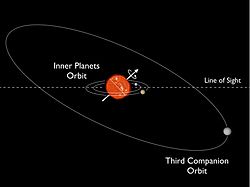 Graphical sketch of the Kepler-56 system. The line of sight from Earth is illustrated by the dashed line, and dotted lines show the orbits of three detected companions in the system. The solid arrow marks the rotation axis of the host star, and the thin solid line marks the host star equator. Credit: NASA GSFC/Ames/D Huber | |
| Observation data Epoch J2000.0[1] Equinox J2000.0[1] | |
|---|---|
| Constellation | Cygnus |
| Right ascension | 19h 35m 02.0012s[4] |
| Declination | +41° 52′ 18.692″[4] |
| Apparent magnitude (V) | 13 |
| Characteristics | |
| Evolutionary stage | red giant[5] |
| Spectral type | K3III |
| Astrometry | |
| Radial velocity (Rv) | -53.740601[1] km/s |
| Proper motion (μ) | RA: −6.596(12) mas/yr[4] Dec.: −12.081(13) mas/yr[4] |
| Parallax (π) | 1.0755 ± 0.0118 mas[4] |
| Distance | 3,030 ± 30 ly (930 ± 10 pc) |
| Details[5] | |
| Mass | 1.286±0.011 M☉ |
| Radius | 4.179±0.132 R☉ |
| Luminosity (bolometric) | 9.589±0.129 L☉ |
| Temperature | 4973±14 K |
| Metallicity [Fe/H] | 0.0251±0.013 dex |
| Age | 3.917±0.157 Gyr |
| Other designations | |
| Database references | |
| SIMBAD | data |
Kepler-56 is a red giant[6] in constellation Cygnus roughly 3,030 light-years (930 pc) away[4] with slightly more mass than the Sun.
- ^ a b c "Kepler-56". SIMBAD. Centre de données astronomiques de Strasbourg.
- ^ Cite error: The named reference
EPE-Kepler56bwas invoked but never defined (see the help page). - ^ Cite error: The named reference
EPE-Kepler56cwas invoked but never defined (see the help page). - ^ a b c d e Cite error: The named reference
Gaia DR3was invoked but never defined (see the help page). - ^ a b Fellay, L.; Buldgen, G.; et al. (October 22, 2021). "Asteroseismology of evolved stars to constrain the internal transport of angular momentum". Astronomy & Astrophysics. 654. 12. arXiv:2108.02670. doi:10.1051/0004-6361/202140518. S2CID 239652877. Retrieved March 30, 2022.
- ^ Cite error: The named reference
2013Sci...342..331Hwas invoked but never defined (see the help page).